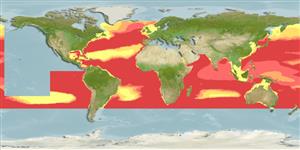Common names from other countries
Environment: milieu / climate zone / depth range / distribution range
Ecology
Marine; bathypelagic; depth range 0 - 2000 m (Ref. 9927), usually 500 - 700 m (Ref. 6744). Deep-water; 65°N - 40°S
Circumglobal: In tropical to temperate waters. Eastern Atlantic: Iceland and British Isles to South Africa including Canary Islands and Ascension Island (Ref. 6744). Northwest Atlantic: Canada (Ref. 5951). Not recorded from the Mediterranean (Ref. 6744).
Size / Weight / Age
Maturity: Lm ? range ? - ? cm
Max length : 27.6 cm TL male/unsexed; (Ref. 5951); common length : 9.0 cm SL male/unsexed; (Ref. 6536)
Juveniles are found from near surface to about 250 m to more than 1,000 m (Ref. 6536). Largest adults may be benthopelagic (Ref. 9851). Adults are plankton-eaters like the other members of the family (Ref. 6744). Oviparous, with planktonic larvae (Ref. 36622).
Life cycle and mating behavior
Maturities | Reproduction | Spawnings | Egg(s) | Fecundities | Larvae
Paxton, J.R., D.F. Hoese, G.R. Allen and J.E. Hanley, 1989. Pisces. Petromyzontidae to Carangidae. Zoological Catalogue of Australia, Vol. 7. Australian Government Publishing Service, Canberra, 665 p. (Ref. 7300)
IUCN Red List Status (Ref. 130435)
CITES (Ref. 128078)
Not Evaluated
Threat to humans
Harmless
Human uses
Fisheries: of potential interest
Tools
Special reports
Download XML
Internet sources
Estimates based on models
Preferred temperature (Ref.
115969): 3.3 - 12.2, mean 8.1 (based on 510 cells).
Phylogenetic diversity index (Ref.
82804): PD
50 = 1.0625 [Uniqueness, from 0.5 = low to 2.0 = high].
Bayesian length-weight: a=0.02630 (0.01238 - 0.05589), b=3.03 (2.83 - 3.23), in cm Total Length, based on LWR estimates for this species & (Sub)family-body (Ref.
93245).
Trophic level (Ref.
69278): 3.4 ±0.45 se; based on food items.
Fishing Vulnerability (Ref.
59153): Low vulnerability (18 of 100).
